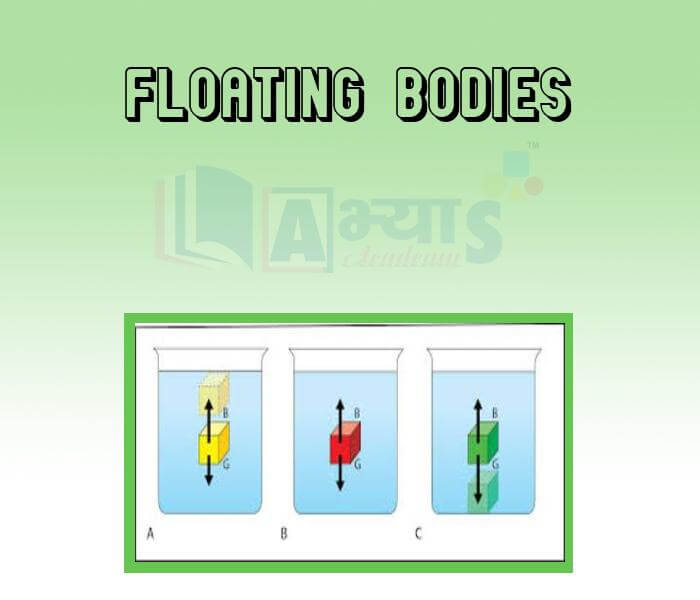Floating Bodies













Floating Bodies
Floating Bodies: If the weight of the submerged object is greater than the buoyant force, the object will sink. If the weight is equal to the buoyant force acting up on the submerged object, it will remain at any level, like a fish. If the buoyant force is greater than the weight of the completely submerged object, it will rise to the surface and float.
To understand buoyancy the meaning of the term volume of liquid displaced should be clearly understood. If a stone is placed in a container that is full of water, some water will overflow as shown in submerged object always displace a volume of lquid equal to its own volume.
Buoyant force is also called upthrust. Upthrust depends on the density of the liquid, not on the density of the object.
Floating or Sinking of Objects in Liquid:
When an object is immersed in a liquid, then following two forces act on it:
Whether an object will float or sink in a liquid, depends on the relative magnitudes of those two forces which act on the object in opposite directions. There are three conditions of floating and sinking of objects. These are:
(i) If the buoyant force or upthrust exerted by the liquid is less than the weight of the object, the obejct will sink in the liquid.
(ii) If the buoyant force is equal to the weight of the object, the object will float in the liquid.
(iii) If the buoyant force is more than the weight of the object, the object will rise in the liquid and the float.
A wooden block is floating in water contained in a beaker. During the free fall of the beaker, the upthrust on the block will be | |||
| Right Option : D | |||
| View Explanation |
Which of the following are correct : (a) Buoyant force is also called upthrust, it depends on the density of the liquid, not on the density of the object. (b) If the buoyant force or upthrust exerted by the liquid is less than the weight of the object, the object will sink in the liquid. (c) If the buoyant force or upthrust exerted by the liquid is equal to the weight of the object, the object will sink in the liquid. | |||
| Right Option : C | |||
| View Explanation | |||
Which of the following are correct : (a) If the weight of the submerged object is greater than the buoyant force, the object will sink. (b) If the weight of the submerged object is greater than the buoyant force, the object will float.. | |||
| Right Option : A | |||
| View Explanation | |||
Students / Parents Reviews [10]
It was a good experience with Abhyas Academy. I even faced problems in starting but slowly and steadily overcomed. Especially reasoning classes helped me a lot.

Cheshta
10thA marvelous experience with Abhyas. I am glad to share that my ward has achieved more than enough at the Ambala ABHYAS centre. Years have passed on and more and more he has gained. May the centre flourish and develop day by day by the grace of God.

Archit Segal
7thBeing a parent, I saw my daughter improvement in her studies by seeing a good result in all day to day compititive exam TMO, NSO, IEO etc and as well as studies. I have got a fruitful result from my daughter.

Prisha Gupta
8thAbhyas Methodology is very good. It is based on according to student and each child manages accordingly to its properly. Methodology has improved the abilities of students to shine them in future.

Manish Kumar
10thMy experience with Abhyas is very good. I have learnt many things here like vedic maths and reasoning also. Teachers here first take our doubts and then there are assignments to verify our weak points.

Shivam Rana
7thMy experience with Abhyas academy is very good. I did not think that my every subject coming here will be so strong. The main thing is that the online tests had made me learn here more things.

Hiya Gupta
8thI have spent a wonderful time in Abhyas academy. It has made my reasoning more apt, English more stronger and Maths an interesting subject for me. It has given me a habbit of self studying

Yatharthi Sharma
10thAbhyas is a complete education Institute. Here extreme care is taken by teacher with the help of regular exam. Extra classes also conducted by the institute, if the student is weak.

Om Umang
10thIt was good as the experience because as we had come here we had been improved in a such envirnment created here.Extra is taught which is beneficial for future.

Eshan Arora
8thIt has a great methodology. Students here can get analysis to their test quickly.We can learn easily through PPTs and the testing methods are good. We know that where we have to practice
